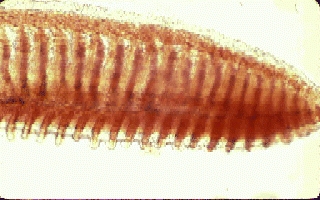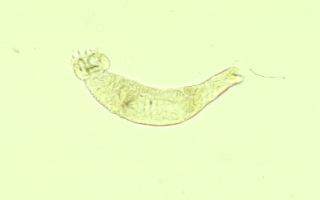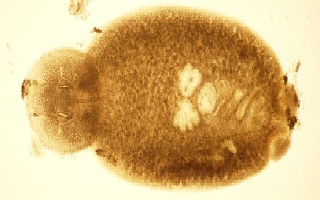
Examine gills and select an area that appears abnormal. Using scissors clip several gill filaments, remove clippings from gill arch with forceps and place inot a drop of saline on a clean glass slide. Cover with a slip cover, and additional saline if needed.
This is a normal gill:

Microscopically in wet-mount preparations normal gills of tilapia have a uniform appearance. The individual lamellae on the gill filaments are visible as distinct structures that contain rows of red blood cells. The lamellae are free of ectoparasites, aneurisms and excessive accumulations of epidermal cells or mucus.
Compare your sample with the following Disease Vectors:
Amyloodinium sp 0.03 to 0.05 mm spherical
to pear shaped and attached by a short stalk. blackish in color and vacuolated
(e.g. full of tiny spherical bubbles) under transmitted light


Digenetic Trematodes parasitic flatworms.
Second picture shows the worms mouth at 400X


Gas Bubble Disease Note the elongated
bubble trapped in the tissue. A bubble accidentally trapped under the slide
cover will typically be more circular.

Gill Aneurism discrete, often rather circular
swollen areas filled with red blood cells in the gill lamellae

Ichthyobodo sp. (Costia), a flagellated
ectoparasite. VERY small, about 0.007 mm or the size of a red blood cell.
It may be found attached to gill or skin cells by its narrow end or moving
in a jerky circular motion in the wet-mount fluid near the tissue

Myxobacteria long (0.003-0.01 mm) thin (0.0005
mm) rod shaped bacteria often seen in clumps or "stacks" which move by flexing
or gliding.

Ichthyophthirius multifiliis (Ich, marine: Cryptocaryon
irritans), a protozoan ectoparasite. can vary in size from 0.02 mm to nearly
1 mm depending on the age of the parasite The cilia along the perimeter of
the organism beats and slowly propels the protozoan forward. Under transmitted
light in wet-mount preparations, Ich appears brownish in color.

Saprolegnia spp. fungi at 100X to 400X appears
as a branching tangle of root-like filaments (e.g. the hyphae). The filaments
are clear and about 0.005 mm in diameter.

Monogenetic Trematodes parasitic
flatworms. May be small (0.3 to 0.4 mm) on the gills or skin. Hooks on one
end may be attached to the host fish. If still alive, will flex rapidly or
contract slowly.




Scyphidia sp. a free-living protozoan. stumpy
(~0.04 mm in height), cylindrical shaped with a ring of cilia around the
apical end and an expanded sucker shaped basal end in contact with the skin
of the fish. when detached from the fish change to a fast moving saucer
shape.

Tricodina sp., a protozoan ectoparasites ~0.04
mm circular saucer shaped and very fast moving when alive. rimmed by cilia
and on the bottom side. peculiar denticular rings with teeth that point
inward.


| file: /Techref/other/pond/tilapia/gills.htm, 4KB, , updated: 2009/7/14 08:15, local time: 2025/10/10 03:02,
216.73.216.137,10-3-124-149:LOG IN
|
| ©2025 These pages are served without commercial sponsorship. (No popup ads, etc...).Bandwidth abuse increases hosting cost forcing sponsorship or shutdown. This server aggressively defends against automated copying for any reason including offline viewing, duplication, etc... Please respect this requirement and DO NOT RIP THIS SITE. Questions? <A HREF="http://massmind.org/Techref/other/pond/tilapia/gills.htm"> Tilapia Topic: Gill Microscopy</A> |
| Did you find what you needed? |
Welcome to massmind.org! |
|
Ashley Roll has put together a really nice little unit here. Leave off the MAX232 and keep these handy for the few times you need true RS232! |
.